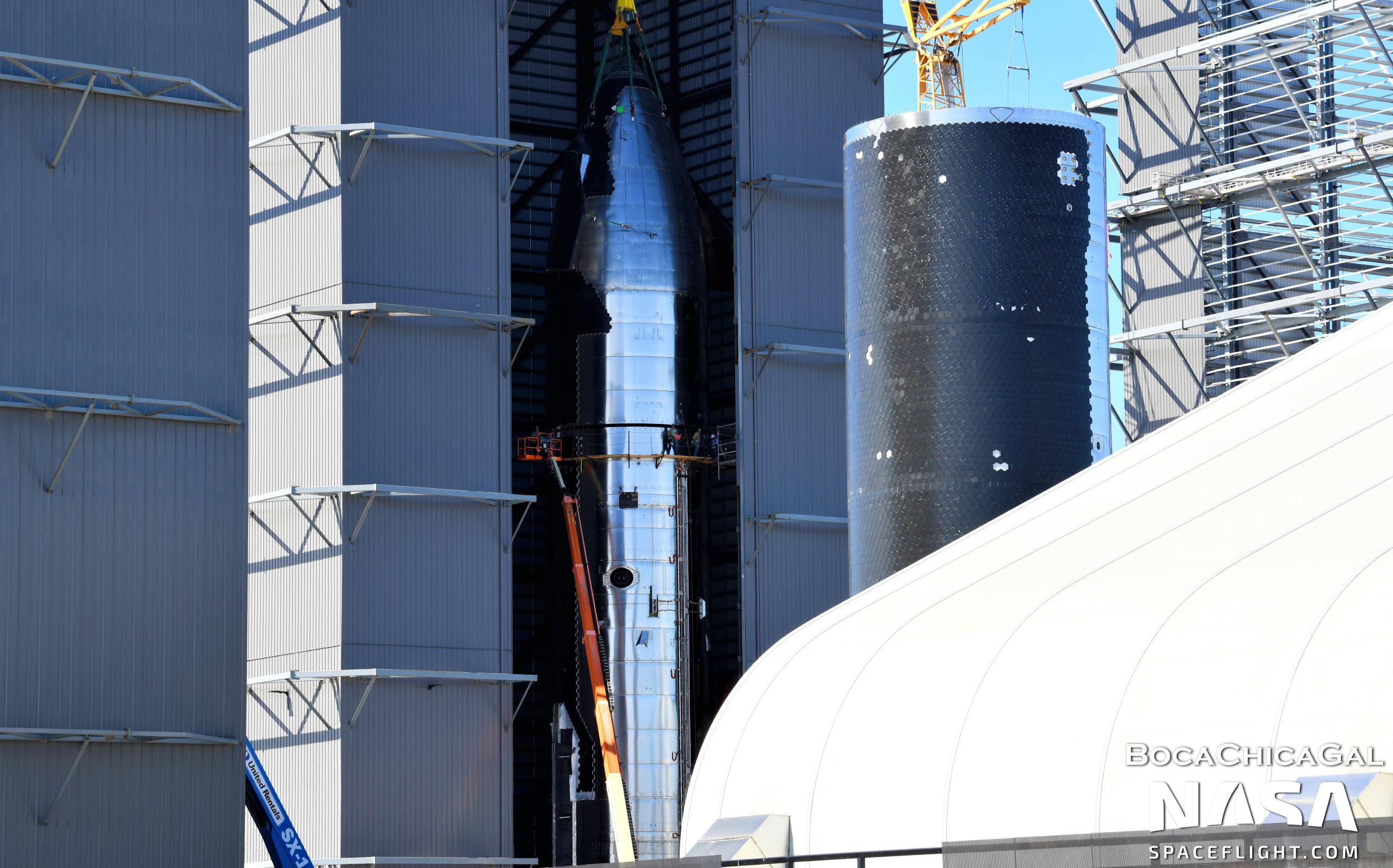
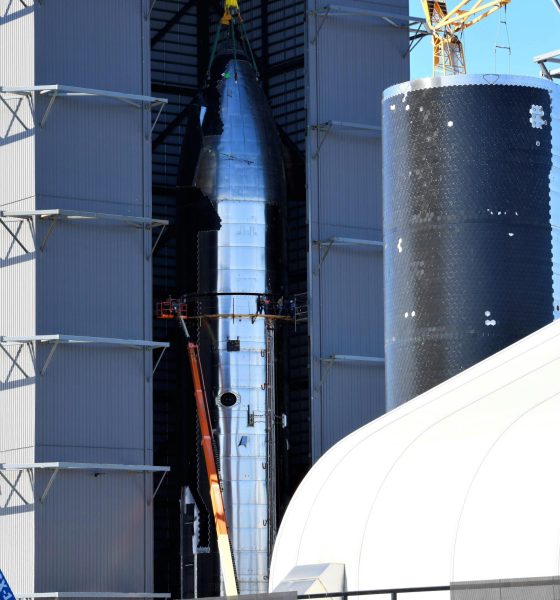
News
SpaceX finishes stacking new Starship for the first time in six months
For the first time in more than half a year, SpaceX has stacked a new Starship prototype to its full height, hopefully marking the end of a period of relatively slow progress.
That period began when Starship S20 was stacked to its full height in early August 2021. Until very recently, Ship 20 was said and expected to be the prototype assigned to Starship’s first orbital test flight, making it exceptionally important. In an unusual change in attitude, SpaceX may have felt the same, which may explain why Starship S20’s first static fire test took place more than two months after it first left the factory. A year prior, Starships SN9, SN10, SN11, and SN15 all completed proof testing a matter of weeks after rollout.
That sudden change of pace relative to past development has meant that Ship 20 is the only Starship prototype SpaceX has tested since May 2021 and the only Starship to graduate from final assembly to testing in the last six months. In that period, Ship 20 has completed a few major cryogenic proof tests and four static fires – two of which ignited all six Raptor engines. While Ship 20’s six-engine tests were unprecedented and marked a major program milestone, SpaceX once static-fired Starship SN9 three times in one day in January 2021.
However, that period of sluggish prototype testing may finally be coming to an end. In August 2021, when SpaceX stacked Starship S20 and Super Heavy B4 for the first time, the general assumption was that the seemingly imminent march towards orbital flight testing would be similar to SpaceX’s attempts to land a Starship from medium altitude between December 2020 and May 2021 – lots of prototypes in flow and multiple back-to-back tests and launches, in other words. That was not the case.
Starship S21, for example, began final assembly in mid-October 2021 and its tank section and nose section were both fully stacked less than a month later. However, rather than stack them into a second complete ship, SpaceX has left those separate assemblies sitting around Starbase for the last three months. Simultaneously, while Ship 21’s apparent limbo seemed to imply that SpaceX was implementing another block upgrade and moving on to newer prototypes, the company actually started stacking Starship S22 about a week after S21’s separate sections were completed. Only three months later have SpaceX’s plans for those three sections finally become clear.
On February 14th, 2022, Ship 22’s tank section followed Ship 21’s nose section into Starbase’s high bay assembly facility, where they were quickly stacked to form a full Starship prototype the same day. This raises the question: why?
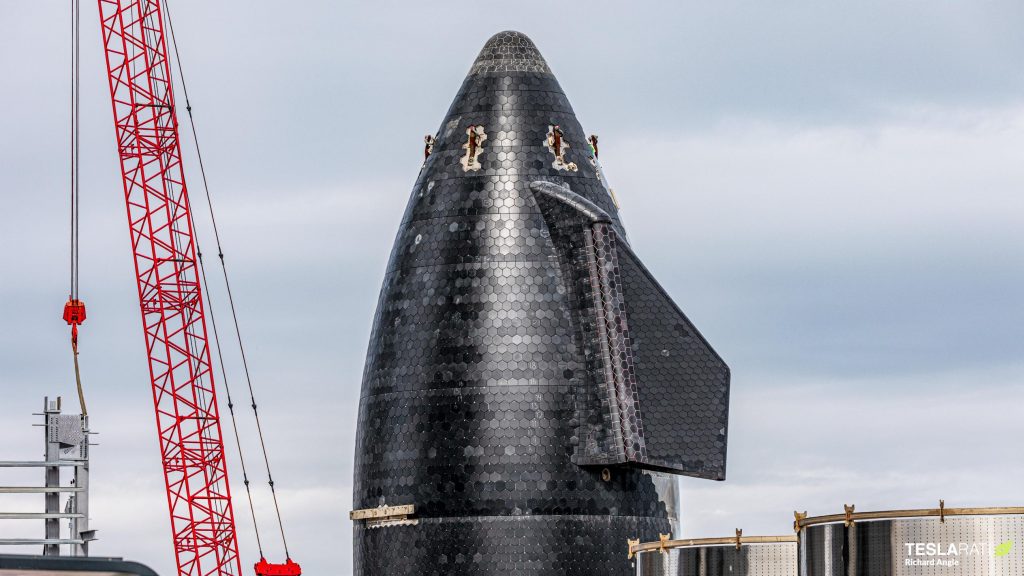
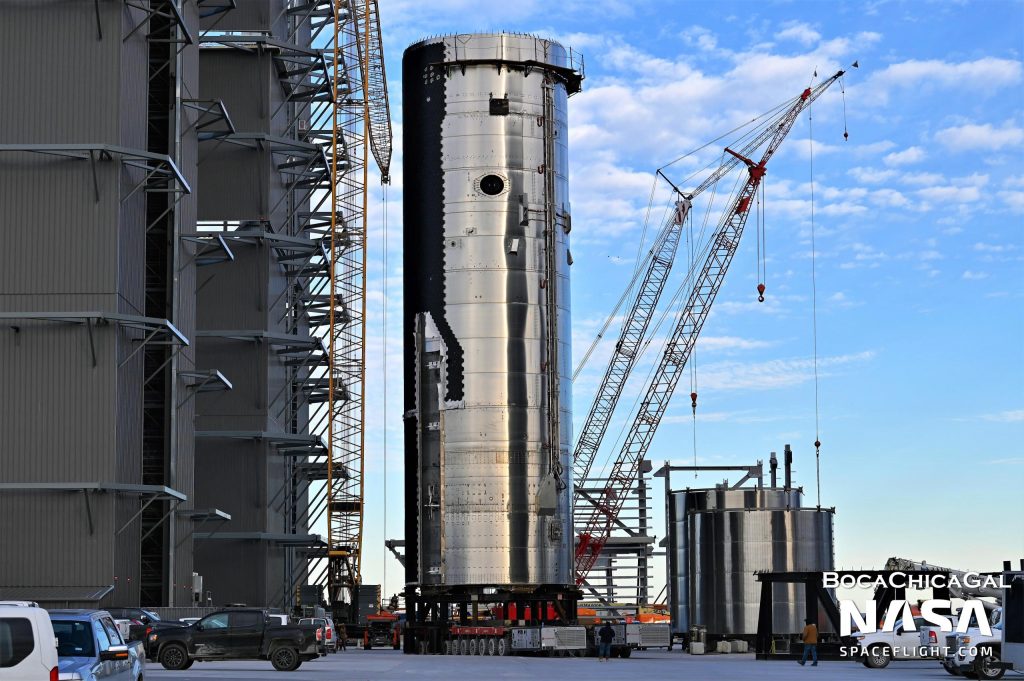
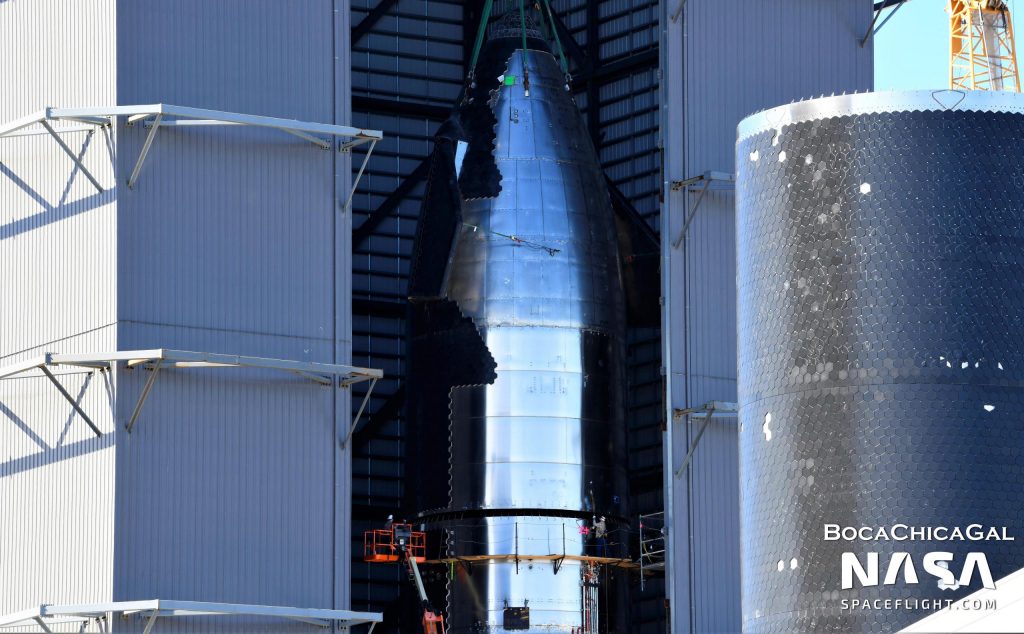
Given that Starship S20 effectively completed qualification testing with three successful static fires in December 2021 and a fourth in early January 2022 and has been seemingly ready to fly ever since, its Super Heavy booster readiness – not ship readiness – that appears to be holding SpaceX back. Perhaps because of pad readiness issues, SpaceX has yet to perform a single Super Heavy static fire test – or even a less risky wet dress rehearsal – at the orbital launch site. As such, it’s hard to say why SpaceX has suddenly decided to finish Ship 22 instead of focusing on a newer version of Starship (S24) and Super Heavy (B7) – both of which are expected to debut upgrades.
It’s possible that Ship 22 is being completed merely as practice for the Starbase workforce, who have gone half a year without fully assembling another ship prototype, but then there would have been no reason not to install Ship 21’s nose on Ship 21’s tank section instead of withholding it for Ship 22. Ship 22 could also be a replacement for Ship 21 if appearances are misleading and SpaceX uncovered issues with the older prototype during testing but again, no booster is ready to launch either ship.
Regardless of the outcome or purpose of Ship 22, seeing any new Starship prototype completed is an exciting and interesting change of pace after half a year of following the windy paths of Ship 20, Booster 5, and Ship 21 to their uncertain goals.

Elon Musk
Elon Musk’s X will start using a Tesla-like software update strategy
The initiative seems designed to accelerate updates to the social media platform, while maintaining maximum transparency.

Elon Musk’s social media platform X will adopt a Tesla-esque approach to software updates for its algorithm.
The initiative seems designed to accelerate updates to the social media platform, while maintaining maximum transparency.
X’s updates to its updates
As per Musk in a post on X, the social media company will be making a new algorithm to determine what organic and advertising posts are recommended to users. These updates would then be repeated every four weeks.
“We will make the new 𝕏 algorithm, including all code used to determine what organic and advertising posts are recommended to users, open source in 7 days. This will be repeated every 4 weeks, with comprehensive developer notes, to help you understand what changed,” Musk wrote in his post.
The initiative somewhat mirrors Tesla’s over-the-air update model, where vehicle software is regularly refined and pushed to users with detailed release notes. This should allow users to better understand the details of X’s every update and foster a healthy feedback loop for the social media platform.
xAI and X
X, formerly Twitter, has been acquired by Elon Musk’s artificial intelligence startup, xAI last year. Since then, xAI has seen a rapid rise in valuation. Following the company’s the company’s upsized $20 billion Series E funding round, estimates now suggest that xAI is worth tens about $230 to $235 billion. That’s several times larger than Tesla when Elon Musk received his controversial 2018 CEO Performance Award.
As per xAI, the Series E funding round attracted a diverse group of investors, including Valor Equity Partners, Stepstone Group, Fidelity Management & Research Company, Qatar Investment Authority, MGX, and Baron Capital Group, among others. Strategic partners NVIDIA and Cisco Investments also continued support for building the world’s largest GPU clusters.
News
Tesla FSD Supervised wins MotorTrend’s Best Driver Assistance Award
The decision marks a notable reversal for the publication from prior years, with judges citing major real-world improvements that pushed Tesla’s latest FSD software ahead of every competing ADAS system.

Tesla’s Full Self-Driving (Supervised) system has been named the best driver-assistance technology on the market, earning top honors at the 2026 MotorTrend Best Tech Awards.
The decision marks a notable reversal for the publication from prior years, with judges citing major real-world improvements that pushed Tesla’s latest FSD software ahead of every competing ADAS system. And it wasn’t even close.
MotorTrend reverses course
MotorTrend awarded Tesla FSD (Supervised) its 2026 Best Tech Driver Assistance title after extensive testing of the latest v14 software. The publication acknowledged that it had previously criticized earlier versions of FSD for erratic behavior and near-miss incidents, ultimately favoring rivals such as GM’s Super Cruise in earlier evaluations.
According to MotorTrend, the newest iteration of FSD resolved many of those shortcomings. Testers said v14 showed far smoother behavior in complex urban scenarios, including unprotected left turns, traffic circles, emergency vehicles, and dense city streets. While the system still requires constant driver supervision, judges concluded that no other advanced driver-assistance system currently matches its breadth of capability.
Unlike rival systems that rely on combinations of cameras, radar, lidar, and mapped highways, Tesla’s FSD operates using a camera-only approach and is capable of driving on city streets, rural roads, and freeways. MotorTrend stated that pure utility, the ability to handle nearly all road types, ultimately separated FSD from competitors like Ford BlueCruise, GM Super Cruise, and BMW’s Highway Assistant.
High cost and high capability
MotorTrend also addressed FSD’s pricing, which remains significantly higher than rival systems. Tesla currently charges $8,000 for a one-time purchase or $99 per month for a subscription, compared with far lower upfront and subscription costs from other automakers. The publication noted that the premium is justified given FSD’s unmatched scope and continuous software evolution.
Safety remained a central focus of the evaluation. While testers reported collision-free operation over thousands of miles, they noted ongoing concerns around FSD’s configurable driving modes, including options that allow aggressive driving and speeds beyond posted limits. MotorTrend emphasized that, like all Level 2 systems, FSD still depends on a fully attentive human driver at all times.
Despite those caveats, the publication concluded that Tesla’s rapid software progress fundamentally reshaped the competitive landscape. For drivers seeking the most capable hands-on driver-assistance system available today, MotorTrend concluded Tesla FSD (Supervised) now stands alone at the top.
News
Elon Musk’s Grokipedia surges to 5.6M articles, almost 79% of English Wikipedia
The explosive growth marks a major milestone for the AI-powered online encyclopedia, which was launched by Elon Musk’s xAI just months ago.

Elon Musk’s Grokipedia has grown to an impressive 5,615,201 articles as of today, closing in on 79% of the English Wikipedia’s current total of 7,119,376 articles.
The explosive growth marks a major milestone for the AI-powered online encyclopedia, which was launched by Elon Musk’s xAI just months ago. Needless to say, it would only be a matter of time before Grokipedia exceeds English Wikipedia in sheer volume.
Grokipedia’s rapid growth
xAI’s vision for Grokipedia emphasizes neutrality, while Grok’s reasoning capabilities allow for fast drafting and fact-checking. When Elon Musk announced the initiative in late September 2025, he noted that Grokipedia would be an improvement to Wikipedia because it would be designed to avoid bias.
At the time, Musk noted that Grokipedia “is a necessary step towards the xAI goal of understanding the Universe.”
Grokipedia was launched in late October, and while xAI was careful to list it only as Version 0.1 at the time, the online encyclopedia immediately earned praise. Wikipedia co-founder Larry Sanger highlighted the project’s innovative approach, noting how it leverages AI to fill knowledge gaps and enable rapid updates. Netizens also observed how Grokipedia tends to present articles in a more objective manner compared to Wikipedia, which is edited by humans.
Elon Musk’s ambitious plans
With 5,615,201 total articles, Grokipedia has now grown to almost 79% of English Wikipedia’s article base. This is incredibly quick, though Grokipedia remains text-only for now. xAI, for its part, has now updated the online encyclopedia’s iteration to v0.2.
Elon Musk has shared bold ideas for Grokipedia, including sending a record of the entire knowledge base to space as part of xAI’s mission to preserve and expand human understanding. At some point, Musk stated that Grokipedia will be renamed to Encyclopedia Galactica, and it will be sent to the cosmos.
“When Grokipedia is good enough (long way to go), we will change the name to Encyclopedia Galactica. It will be an open source distillation of all knowledge, including audio, images and video. Join xAI to help build the sci-fi version of the Library of Alexandria!” Musk wrote, adding in a later post that “Copies will be etched in stone and sent to the Moon, Mars and beyond. This time, it will not be lost.”








